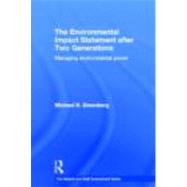- ISBN: 9780415601733 | 0415601738
- Cover: Hardcover
- Copyright: 2/13/2012
This book is about a subject that Michael Greenberg has worked on and lived with for almost 40 years. He was brought up in the south Bronx at a time when his neighborhood suffered from terrible air and noise pollution, and domestic waste went untreated into the Hudson River. For him, the National Environmental Policy Act (NEPA) was a blessing. It included an ethical position about the environment, and the law required some level of accountability in the form of an environmental impact statement, or EIS. Since then he has read the law and regulations that followed from it, worked on some environmental impact statements, read sections of many, conversed with people who prepared them, and those who have reacted to them. And while many of the analyses of the law and of the EIS process are helpful, they tend to be painted in black and white, without enough of the subtleties and nuances that happen in the real world and in particular away from the winner-takes-all forum of the law courts. Only a tiny minority of cases end up in the courts, and the vast majority of EIS processes are resolved by discussion and negotiation rather than litigation. To properly evaluate an EIS means reading tables of data and lengthy case studies and illustrations as evidence, and reading environmental and risk evaluations that are painted in shades of gray. It might mean that the analysts did more than adequate job of measuring impacts on cultural artifacts, but failed to adequately assess the noise impacts. After 40 years of thinking about and working with NEPA and the EIS process, Michael Greenberg decided to conduct his own evaluation from the perspective of a person trained in science who focuses on environmental and environmental health policies. This book of carefully chosen real case studies goes beyond the familiar checklists of what to do, and shows students and practitioners alike what really happens during the creation and implementation of an EIS.






